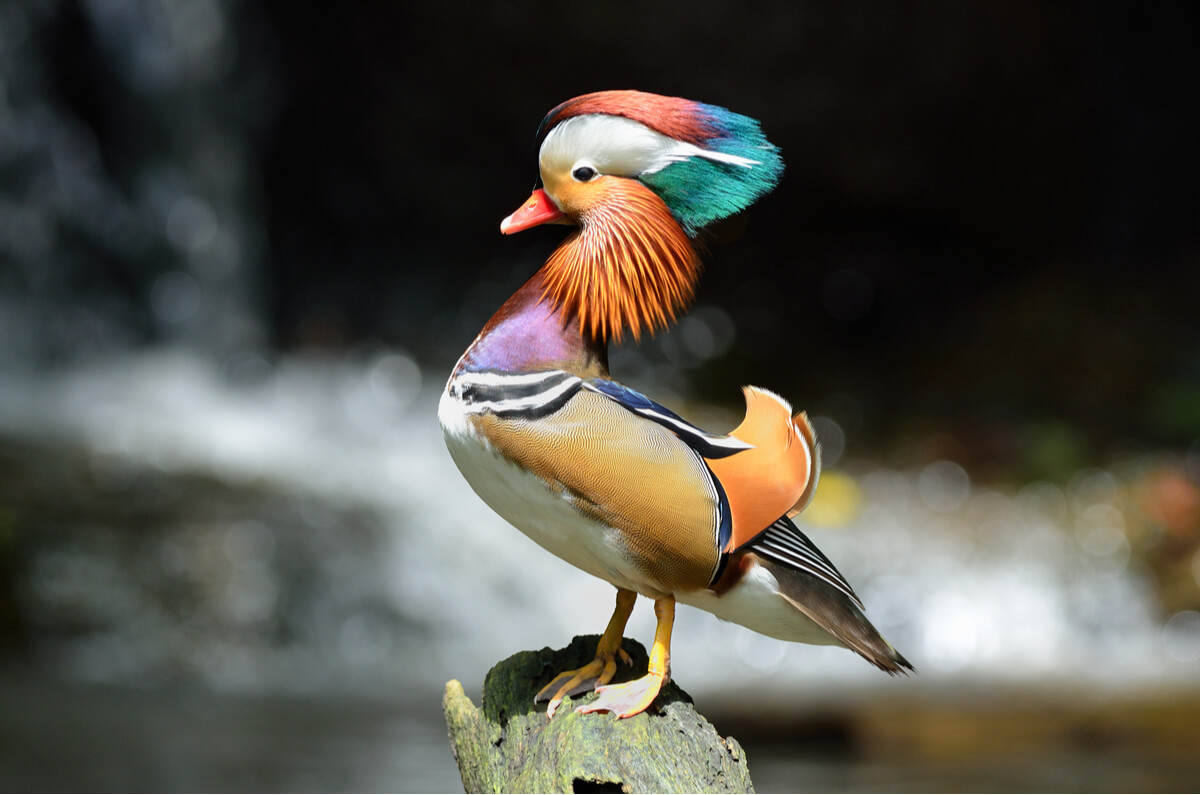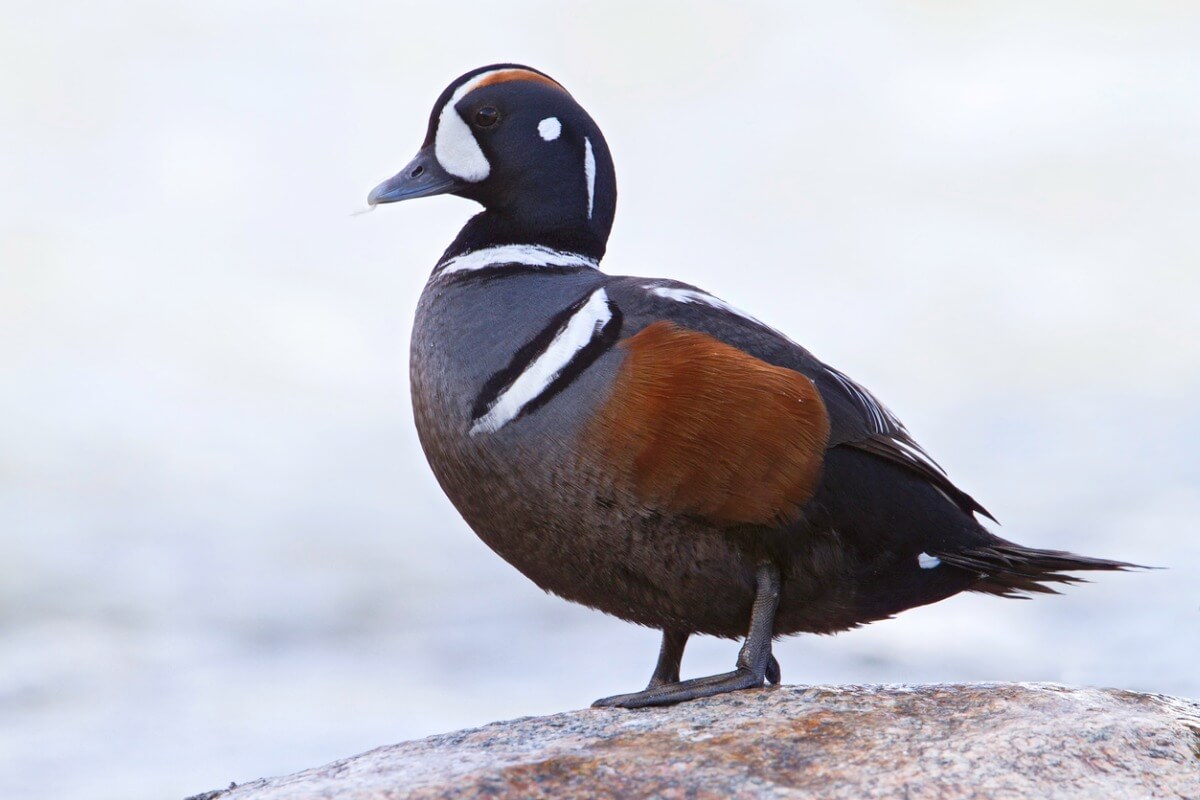11 Types of Ducks

Ducks are a fairly popular group of birds belonging to the family Anatidae. They’re known to be social migratory animals that form flocks during their flights, as well as producing a particular vocalization called quacking. Welcome to our special guide to 11 different types of ducks.
The term “ducks” actually groups together a vast number of bird species. All with similar characteristics, but completely different from each other. One of the best-known types of ducks is Anas platyrhynchos, characterized by its beautiful plumage and great social behavior. However, it isn’t the only one with unique traits. Continue reading and discover what other types of ducks exist in nature.
Types of ducks
The term “ducks” doesn’t have taxonomic utility. Although it groups different species that are closely related to each other, it ignores others in the same group, such as geese and swans. Despite this, it’s a colloquial term that is often used because of the great similarity between their characteristics. Therefore, it isn’t wrong to use it in a colloquial context.
Most birds that are called ducks belong to the genus Anas, although not all species meet this requirement. In fact, there are 10 subfamilies containing the different types of ducks:
- Anatinae: 15 genera
- Anserinae: 6 genera
- Aythyinae: 3 genera
- Dendrocyqninae: 1 genus
- Merginae: 11 genera
- Oxyurinae: 4 genera
- Plectropterinae: 1 genus
- Stictonettinae: 1 genus
- Tadorninae: 6 genera
- Thalassorninae: 1 genus
It’s difficult to quantify how many types of ducks exist, as several more species may still be discovered. However, some of the best-known members are listed below.
1. Mandarin duck (Aix galericulata)
This specimen is characterized by its wonderful and beautiful plumage, which combines red, green, brown, black and white tones all over its body. However, this incredible coloration is only visible in the males, as the females only have gray and white plumage. It’s endemic to Asia and has a large presence in Japan and China.

2. Southern wigeon (Anas sibilatrix or Mareca sibilatrix)
The southern wigeon is endemic to South America, where it’s also known as the Chiloé wigeon. It lives in lakes and rivers with little current, and prefers areas with great depth. It doesn’t have good diving skills, so it feeds on surface vegetation and some seeds.
3. Spectacled Duck (Speculanas specularis)
The spectacled duck is also endemic to South America, but its distribution is restricted to southern Chile and Argentina. It’s so named because it has a white spot on its face just in front of the eye, which makes it look as if it has spectacles. It’s also known as the bronze-winged duck.
4. Red-crested pochard (Netta rufina)
This is a duck with one of the most elegant plumages, with a head with reddish tones, a black body, and a brown back with white lines. Of course, only the males have the showy plumage, while females have brown plumage with small white areas.
5. Muscovy duck (Cairina moschata)
This duck is characterized by its black plumage all over its body. It can be found in the Americas, from Mexico to Argentina and Uruguay, so it’s common in the continent. In fact, thanks to its beautiful coloration, it has even been bred as a pet.
6. Harlequin duck (Histrionicus histrionicus)
The harlequin duck is a specimen that has one of the most peculiar plumages among the different types of ducks. In general, its entire body is black with some red spots on both the face and wings, but it also has several white lines dividing its body.

7. Brazilian merganser (Mergus octosetaceus)
Among all the different types of ducks, there are some that have very curious characteristics on their plumage. One of these specimens is the Brazilian merganser, which has a type of crest on its head that protrudes from its body. Although its plumage isn’t very showy in colors such as black and gray, its crest makes it stand out.
8. Ruddy duck (Oxyura jamaicensis)
The Ruddy duck can be found in several regions of North America, so it could be considered a common species on the continent. It’s recognized for its great swimming and diving abilities in lakes and ponds. It also has a curious bluish bill and reddish-brown plumage with white spots.
9. Freckled duck (Stictonetta naevosa)
This species of duck receives its name thanks to the peculiar coloration of its plumage, which has dark tones with small white spots along the body. It’s endemic to Australia and lives in different swamps, lagoons, and rivers. Despite its beautiful appearance, the freckled duck has problems with habitat destruction, so special programs have been established to protect it.
10. Fulvous whistling duck (Dendrocygna bicolor)
The fulvous whistling duck can be found in India, Africa, and Central and South America. The plumage of this bird is characterized by being monochromatic and exhibiting brownish tones along its body. In addition, it has a gray bill and legs that contrast perfectly with this color pattern.
11. Torrent duck (Merganetta armata)
The torrent duck is a species that lives in the fast-flowing rivers of the Andes Mountains. This means that it inhabits ecosystems between 1500 and 4500 meters above sea level (5000 to 15000 feet), with cold and almost freezing temperatures.
Both sexes are characterized by their colorful plumage. While the male has a white coloration with gray lines, the female exhibits orange feathers on the belly and gray on the back.
The group of ducks is quite extensive and diverse, which gives them different particularities. It’s impossible to name all the species that exist today. However, the above examples make it clear that these birds are both amazing and beautiful.
All cited sources were thoroughly reviewed by our team to ensure their quality, reliability, currency, and validity. The bibliography of this article was considered reliable and of academic or scientific accuracy.
- Phillips, J. C. (1986). A Natural History of the Ducks: Plectropterinae, Dendrocygninae, Anatinae (in part)(1 v.) (Vol. 1). Courier Corporation.
- Makram, A. (2016, November). Ducks world. In Proceedings of the 9th international poultry conference (pp. 7-10).
- Johnsgard, P. A. (2010). Ducks, Geese, and Swans of the World, Revised Edition [complete work].
- Kear, J. (Ed.). (2005). Ducks, geese and swans: species accounts (Cairina to Mergus) (Vol. 2). Oxford University Press.
- Baldassarre, G. (2014). Ducks, geese, and swans of North America. JHU Press.
This text is provided for informational purposes only and does not replace consultation with a professional. If in doubt, consult your specialist.